|
|
|
Sort Order |
|
|
|
Items / Page
|
|
|
|
|
|
|
| Srl | Item |
| 1 |
ID:
090939
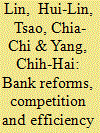

|
|
|
|
|
| Publication |
2009.
|
| Summary/Abstract |
This paper analyzes technical efficiency in China's banking system by large banks and small city banks as well as the pre-WTO and post-WTO accession periods. Using an unbalanced panel dataset for 63 banks over 1997-2006 and employing the stochastic frontier function approach, the empirical results reveal that the new entrants, small city banks, experienced a slightly higher efficiency score than incumbent large banks, on average. Compared with the pre-WTO accession period, the efficiency score is found to have improved significantly after entry into the WTO as a result of the competition effect. This competition effect is particularly relevant for small city banks. Finally, determinants of X-inefficiency are examined.
|
|
|
|
|
|
|
|
|
|
|
|
|
|
|
|
| 2 |
ID:
090936


|
|
|
|
|
| Publication |
2009.
|
| Summary/Abstract |
Since China introduced a new managed floating exchange rate regime in 2005, the persistent appreciation of the renminbi against the US dollar has led Chinese firms to reassess their choice of invoice currency among the dollar and other international alternatives to price their exports. The present paper performs a systematic invoice currency analysis by surveying the published literature, summarizing criteria for decision-making, and evaluating the choices available to Chinese exporters implementing currency invoicing strategies to maximize expected profits. This study finds that the euro could play an increasing role as the invoice currency of Chinese firms, although the US dollar will still play a dominant role. Chinese exporters might shift gradually from the dollar to the euro in the face of the falling dollar, balancing between the two by necessity.
|
|
|
|
|
|
|
|
|
|
|
|
|
|
|
|
| 3 |
ID:
090934
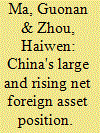

|
|
|
|
|
| Publication |
2009.
|
| Summary/Abstract |
China's emergence as a major player in world trade is well known, but its growing role in global finance might have been underappreciated. China is the second largest creditor in the world today, with a net creditor position of 30 percent of GDP in 2008. We test the importance of the growth differential, demographics, government debt, financial depth and the exchange rate in shaping China's net foreign asset position. Our empirical results highlight the sharp fall in the young-age dependence as one key driver behind China's puzzlingly large net lender position and also confirm the neoclassical prediction that faster growth attracts more capital inflows. Looking ahead, our findings suggest that China will unlikely turn into a meaningful net debtor nation over the next two decades.
|
|
|
|
|
|
|
|
|
|
|
|
|
|
|
|
| 4 |
ID:
090935


|
|
|
|
|
| Publication |
2009.
|
| Summary/Abstract |
The Chinese Government has stepped up its drive to reconstruct its international financial strategy after the sub-prime crisis developed into a global financial crisis in 2008. The main aim of the strategy is to reduce the country's dependence on the US dollar in foreign trade, cross-border capital flows and foreign exchange reserve management. The strategy can be divided into three tiers: renminbi internationalization, regional monetary cooperation and reconstruction of the international monetary regime. So far, the Chinese Government has fared well in the application of all three tiers. We hold that the Chinese Government should continue in the same direction in a coordinated manner despite various challenges it faces.
|
|
|
|
|
|
|
|
|
|
|
|
|
|
|
|
| 5 |
ID:
090942
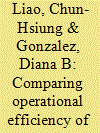

|
|
|
|
|
| Publication |
2009.
|
| Summary/Abstract |
Using partial factor productivity and data envelopment analysis approaches, this study measures and compares the operational efficiency of the 10 dominant mobile operators in Brazil, Russia, India and China (BRIC) between 2002 and 2006. The results of data envelopment analysis indicate that the two leading Brazilian mobile operators, Vivo and TIM, are fully efficient throughout the entire period of study; however, Indian mobile operators are the least efficient among BRIC operators. Interestingly, the findings of this study verify that full operational efficiency can be achieved by operators with large revenues, such as China Unicom, and by others with medium and small revenues, such as Vivo, TIM and Oi. Partial factor productivity demonstrates that 3 of the 4 Brazilian mobile operators, Vivo, TIM and Oi, have remarkable productivity ratios, and that the state-owned operator, China Unicom, has the highest revenue per capital expenditure among BRIC operators. In contrast, Indian mobile operators' productivity ratios are generally low compared to other BRIC mobile carriers.
|
|
|
|
|
|
|
|
|
|
|
|
|
|
|
|
| 6 |
ID:
090940
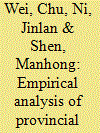

|
|
|
|
|
| Publication |
2009.
|
| Summary/Abstract |
This paper proposes an energy efficiency index based on the data envelopment analysis approach. The index is used to examine energy efficiency in China. Using 1997-2006 panel data for 29 provinces, we find that energy efficiency is negatively associated with the secondary industry share in GDP, the state-owned economic share in GDP and the government expenditure share in GDP, and is positively associated with the technical level and non-coal share in energy consumption. In addition, we find that there exists a large gap in energy efficiency among eastern, central and western regions. The eastern region has a significantly higher energy efficiency level than the central and western regions. We conclude that the different levels of industry structure, government intervention, energy structure, and the technology content in the three regions lead to the differences in energy efficiency.
|
|
|
|
|
|
|
|
|
|
|
|
|
|
|
|
| 7 |
ID:
090938
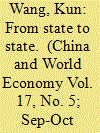

|
|
|
|
|
| Publication |
2009.
|
| Summary/Abstract |
This paper uses a sample of Chinese listed companies whose controlling shareholders have changed from government agencies to state-owned enterprises (SOEs), to examine whether reducing government intervention while maintaining government's ultimate control could improve firm performance. The results show that the overall performance of these firms improves after the transfer of their controlling shareholders, due to improvements in both operating and non-operating performance. When we separate all samples into solely SOEs and other SOEs based on the controlling shareholder, we find that operating performance improved significantly in the solely SOE group, whereas non-operating performance improved significantly in the SOE group. In addition, we identify sources of performance improvement from two perspectives: corporate governance and related party transactions. The results imply that the Chinese Government should continue to decentralize control and, at the same time, continue to monitor firm operating efficiency.
|
|
|
|
|
|
|
|
|
|
|
|
|
|
|
|
|
|
|
|
|